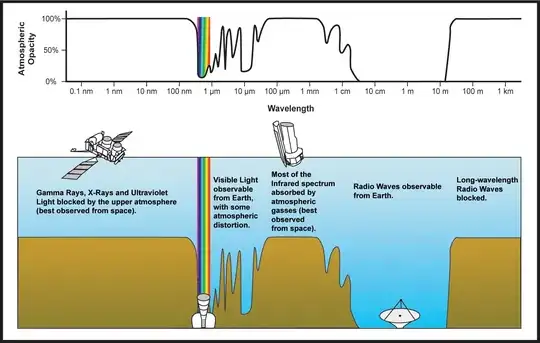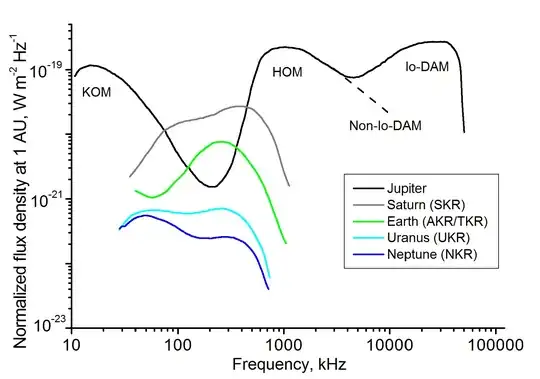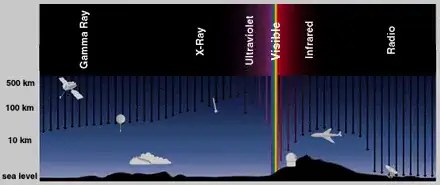How to generate radiation
Radiation by nuclear emission
A moon made of some non-fissile (definitely not fissile!) transuranic element would emit significant alpha, beta, and/or gamma radiation.
Radiation by neutron generation
The moon would have to be a neutron generator. There are a few ways to create neutrons, but they involve things like fission reactors and hydrogen ion linear accelerators. This would basically have to be an alien space station, not a moon. I think that is outside the scope of the question, so I'll ignore neutron radiation.
Radiation by magnetic field
A moon filled with a magneto-hydro-dynamically active fluid would be able to generate a significant magnetic field, the way that Jupiter does. This field will trap charged particles. If something emits lots of charged particles (Io does this for Jupiter; the solar wind may be sufficient for Earth since it is closer to the Sun) then those particles can be trapped to form a high energy plasma in the magnetic field. This is analogous to the Van Allen belts around Earth, though they would be stronger with a stronger magnetic field.
Once you have a very strong magnetic field and very high energy particles in that field (in the keV, 10 million K range), you can emit energy by slamming these particles into something else, namely the atmosphere. This is an aurora. Much of Jupiter's emissions come from its aurorae, while some come from Io and its thin ionosphere passing through Jupiter's magnetically maintained high energy plasma disk.
Jupiter's magnetic field emits radio waves at ~100 GW in the 10-100 m wavelength; IR at ~50 TW in the 3-14 $\mu m$ range; and UV at ~10 TW in the 80-180 nm range. By comparison, Earth's magnetosphere emits only in the radio range at about 0.1 GW.
Radiation by accretion
To generate other wavelengths, like a powerful X-ray source, you need to drop matter into a high gravity object, like a neutron star or a black hole. I don't see any other way for a moon to be an X-ray source, and since this doesn't seem to meet the OP's requirements, I'm going to ignore X-ray radiation.
How radioactive will these sources be?
Alpha and beta radiation
Alpha and beta particles have little to no ability to penetrate the atmosphere, so they are basically out as radiation sources.
Gamma (and X-ray) radiation
Gammas are another story. If the moon were made of something that had a long half-life but emitted gamma radiation, then maybe it would be a potent source.
There are a great variety of metal isotopes with long half-lives (1e5 years +) that emit x-ray radiation in the 5-10 keV range; decay of non-fissile transuranics provides a wide spectrum of emissions in the x-ray to gamma range (up to 15 MeV). This could be nice and deadly, but unfortunately, the atmosphere is a very good absorber of X-rays and gamma radiation.

The attenuation coefficients in air of various energy radiation can be found here. For a 10 keV X-ray, the density coefficient of attenuation ($\mu/\rho$) is 5.12 cm$^2$/g. Multiply this by the density of air (1.2 mg/cm$^3$) and convert to meters for a coefficient ($\mu$) of 6.3 meters$^{-1}$. A half-thickness can be obtained from an attenuation coefficient by dividing the log of 2 by the attenuation constant; the half-thickness for 10 keV X-ray penetration is 0.11 meters. That means, each 0.11 meters drops the power of X-ray radiation in half. Needless to say, X-rays won't make it far in the air.
Gamma rays do better, but not by much. For 1 MeV gamma rays, the half thickness is up to about 9 meters. For 10 MeV gammas it is 28 meters. 28 meters is a serious distance to penetrate, but not so much compared to the thickness of the Earth's atmosphere. For a simulated constant density atmosphere at the density we are using to calculate, the Earth's atmosphere would be about 8 km thick. Divide that distance by 28 and you get 289; so gamma energy from space is reduced by a factor of $2^{289}$ by the time it reaches the surface, not enough to do any damage. A radioactive object in orbit just won't do the trick.
Magnetically induced radiation - Decametric radio
Here is where we get more interesting. Jupiter's aurorae, i.e. the regions where the magnetic field lines intersect with the atmosphere, are extremely powerful radio emitters. You may notice from the above graphic, or from listening to the radio in your car, that radio waves penetrate the atmosphere nicely. The 10cm to 10m band of little atmospheric attenuation corresponds to the 3-300 MHz range; VHF and UHF radio. Here is Jupiter's (and other planets') radio emissions.

The decametric radiation (DAM) in this graph is largely controlled by interactions with the moon Io. The mechanics of these interactions are mostly beyond me, so I can only suggest that there are possible mechanisms for getting large scale radio wave energy released. First, there can be an orbiting satellite which is a massive magnetic field generator for some reason. This satellite acts like Jupiter, while the Earth acts like Io. The magnetic field lines of this satellite interact with the Earth's so that high-energy charged particles captured in the combined magnetic fields are funneled into Earth's poles. This forms powerful aurorae, with tremendous radio emissions.
The last bit of assuming we have to make is that this interaction will be able to create the appropriate decametric radio emissions without putting out too much energy in other frequencies. I am not sure if that is possible at the high energies that his system will require, but I am willing to assume it. We want radio emission to penetrate the Earth's atmosphere cleanly, heating the surface without heating the atmosphere more than it needs to.
Radio wave attenuation in the atmosphere is in the 3-10 db range. Taking an optimistic view, that means that 10-50% of the radio energy will reach the ground, while 50-90% remains in the atmosphere. Once VHF energy hits the ground, nearly all of it will be absorbed.
The goal here will be to get the ground to absorb a lot of radiation, making the ground too hot to support life. The aurora are localized effects; if they occur at an altitude of 100 km, then only a circle about 1000 km in radius is affected. If the aurora were directly over the North pole, for example, the arctic circle would not receive any radiation; it would be blocked by the curvature of the earth.
For the region directly below the aurora, we would like to up the incident radiation by a substantial amount to make the place lifeless. The incident radiation that is absorbed the the surface on Earth averages to 163 W/m$^2$ over the whole surface over a whole year. Let's say our target is to hit the surface with an additional 250 W/m$^2$ in radio energy at the sub-aurora point to sterilize it.
For a low attenuation scenario of 50% atmospheric absorption, an aurora occurring at 100 km must deliver an equivalent to 500 W/m$^2$ at that altitude. At 100 km, the surface area of this radiation would be $4.2\times10^{10}$ m$^2$; so the radio luminosity of a point source must be just about 2 TW. This compares with 0.1 GW distributed over the Earth's entire magnetosphere, or ~40 GW from Jupiter's radio emissions. So this is a lot, but perhaps in the realm of possibility.
In order for the 'moon' object to work, it would have to be in orbit of Earth, but not necessarily geosynchronous orbit. Any object of moon-like size 'could' generate the desired magnetic fields, but it would surely be artificial. It would have to be filled with some sort of magnetic fluid that generated the magnetic fields. Again, this is not my specialty, but I suspect that a very high temperature, low viscosity, high flow rate iron core would work; as would a liquid hydrogen core, as on Earth.
However, having this in a moon-sized object would surely be artificial.
Conclusion
In this scenario, there is an orbiting object that generates extremely high magnetic fields. It is probably artificial. These fields cause solar wind particles to be trapped around the object. When these lines link up with the Earth's in a certain way, the charged particles are discharged into the Earth's atmosphere; there they collide with atmospheric molecules and release radio waves.
Much of the radio waves end up back in space, but the sub-aurora point is hit with the equivalent of equatorial daylight sun, constantly. If these magnetic effects are stable, then within a few days, the ground within a hundred km has heated considerably, and within a week, plant life is being killed by the heat. If the aurora stays in place for at least a month, there will be a dead patch a hundred km across, where nothing survives except bacteria. The auroras are stable for a while, until the magnetic lines drift off, then soon another aurora will pop nearby. Some aurora are so far north that they just melt glaciers to bare rock and are done, others are over the ocean. But when they appear at mid-latitudes over land, beware!
This doesn't meet the geosynchonous criteria, but it would explain why dead spots would appear on a time scale of months in northern latitudes.


